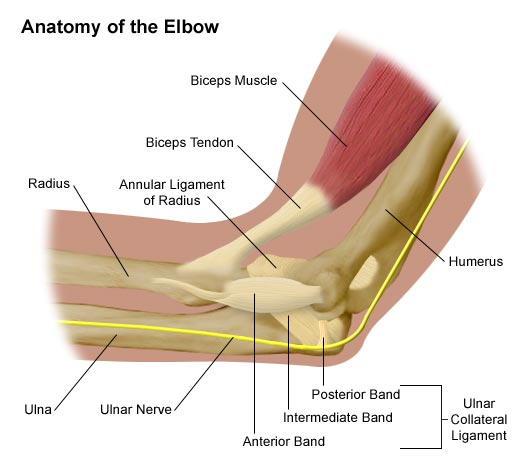Cubital Tunnel Syndrome
What is cubital tunnel syndrome?
Cubital tunnel syndrome happens when the ulnar nerve, which passes through the cubital tunnel (a tunnel of muscle, ligament, and bone) on the inside of the elbow, becomes inflamed, swollen, and irritated.

Cubital tunnel syndrome causes pain that feels a lot like the pain you feel when you hit the "funny bone" in your elbow. The "funny bone" in the elbow is actually the ulnar nerve, a nerve that crosses the elbow. The ulnar nerve starts in the side of your neck and ends in your fingers.
What causes cubital tunnel syndrome?
Cubital tunnel syndrome may happen when a person bends the elbows often (when pulling, reaching, or lifting), leans on their elbow a lot, or has an injury to the area.
Arthritis, bone spurs, and previous fractures or dislocations of the elbow can also cause cubital tunnel syndrome.
In many cases, the cause is not known.
What are the symptoms of cubital tunnel syndrome?
The following are the most common symptoms of cubital tunnel syndrome:
-
Numbness and tingling in the hand or ring and little finger, especially when the elbow is bent
-
Numbness and tingling at night
-
Hand pain
-
Weak grip and clumsiness due to muscle weakness in the affected arm and hand
-
Aching pain on the inside of the elbow
The symptoms of cubital tunnel syndrome may seem like other health conditions or problems, including golfer's elbow (medial epicondylitis). Always see a healthcare provider for a diagnosis.
How is cubital tunnel syndrome diagnosed?
In addition to a complete medical history and physical exam, diagnostic tests for cubital tunnel syndrome may include:
-
Nerve conduction test. This test measures how fast signals travel down a nerve to find a compression or constriction of the nerve.
-
Electromyogram. This test checks nerve and muscle function and may be used to test the forearm muscles controlled by the ulnar nerve. If the muscles don't work the way they should, it may be a sign that there is a problem with the ulnar nerve.
-
X-ray. This is done to look at the bones of the elbow and see if you have arthritis or bone spurs in your elbow.
Cubital Tunnel Syndrome | FAQ with Dr. Sophia Strike
(light music) >> My name is Sophia Strike, and I am one of the hand and upper extremity surgeons at Johns Hopkins. I see patients with problems of the hand and upper extremity as well as patients who have tumors as I have a specialty in orthopedic oncology.
(light music) Cubital tunnel syndrome is a pinching of the large never that goes behind your elbow. So, people often think of it as your funny bone nerve.
(light music) Cubital tunnel syndrome is caused by typically a combination of irritation and compression of the nerve.
Many people sleep with their elbow flexed all the way up at night and actually that traction can cause long-term irritation.
(light music) So nerve symptoms usually consist of a burning or electrical type pain and may cause numbness or tingling in the hand.
Patients may also feel the pain radiating from their elbow down to their hand or up towards their shoulder.
(light music) Carpal tunnel syndrome involves pinching of the nerve at the level of the wrist, whereas cubital tunnel syndrome is pinching of the nerve at the level of the elbow, and typically carpal tunnel will cause numbness and tingling in the three fingers on the thumb side of your hand whereas cubital tunnel will cause numbness and tingling of the two fingers on the small finger side of your hand.
(light music) Cubital tunnel syndrome can also be diagnosed from clinical examination, although when symptoms are not clear we may also send patients for nerve conduction studies.
(light music) The treatment options for cubital tunnel syndrome include nighttime splinting to prevent flexing the elbow all the way up as well as hand therapy for nerve gliding exercises. Some patients who start to have persistent numbness or weakness in their hand from long-term compression of the nerve may require surgical release of the nerve at the elbow.
(light music) Often surgery for cubital tunnel syndrome can be performed with anesthesia that numbs up your arm and does not require full general anesthesia. After surgery, most patients will have some soreness in their elbow, but can go home the same day. Does take somewhere around two to six weeks with usually some hand therapy to help getting motion back for patients to feel like they’re getting back to normal. In the long run, mild symptoms should recover fully, whereas severe symptoms may take longer or may not get back to 100%.
(light music)
How is cubital tunnel syndrome treated?
The most effective treatment for cubital tunnel syndrome is stopping the activity that is causing the problem. Treatment may include:
-
Resting and stopping any activity that aggravates the condition, such as bending the elbow
-
A splint or foam elbow brace worn at night (to limit movement and reduce irritation)
-
Using an elbow pad (to protect against chronic irritation from hard surfaces)
-
Anti-inflammatory medicines (such as ibuprofen or naproxen)
-
Nerve gliding exercises
If these treatments don't work, the healthcare provider may talk to you about surgery.
What can I do to prevent cubital tunnel syndrome?
To prevent cubital tunnel syndrome:
-
Keep your arms flexible and strong.
-
Don't rest on your elbows, especially on a hard surface.
-
Warm up before exercising or using your arms for sports or other repetitive movements.
When should I call my healthcare provider?
Call your healthcare provider if you have:
-
Pain or trouble moving that affects your regular daily activities
-
Pain doesn’t get better or gets worse with treatment
-
Numbness, tingling, or weakness in the arm or hand
Key points about cubital tunnel syndrome
-
Cubital tunnel syndrome is a problem with the ulnar nerve, which passes through the inside of the elbow. It causes pain that feels a lot like the pain you feel when you hit the "funny bone" in your elbow.
-
Cubital tunnel syndrome may happen when a person frequently bends the elbows, leans on their elbow a lot, or has an injury to the area. Arthritis, bone spurs, and previous fractures or dislocations of the elbow can also cause it. In many cases, the cause is not known.
-
The most common symptoms of cubital tunnel syndrome are numbness, tingling, and pain in the hand or ring and little finger, especially when the elbow is bent.
-
Cubital tunnel syndrome can be treated with rest and medicines to help with pain and inflammation. Exercises may help, too. In some cases, surgery may be done.







